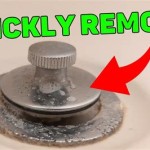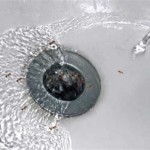Selecting and Utilizing Liquid Cleaners for Bathtubs
Maintaining a clean bathtub is essential for hygiene and overall bathroom aesthetics. Selecting the appropriate liquid cleaner is a crucial step in ensuring effective cleaning without damaging the tub's surface. Various factors should be considered, including the type of material the tub is made of, the nature of the stains or grime, and the potential environmental impact of the cleaning product.
Bathtub materials range from porcelain on steel to acrylic, fiberglass, and even cast iron. Each material possesses different properties and sensitivities to various cleaning agents. Using an inappropriate cleaner can lead to discoloration, etching, or even structural damage. Therefore, understanding the specific needs of the tub's material is paramount to selecting the right liquid cleaner.
Furthermore, the type of soiling present in the bathtub will dictate the strength and type of cleaner required. Common bathtub grime includes soap scum, hard water stains, mildew, and body oils. Each type of residue requires a specific approach to effectively remove it without resorting to harsh chemicals that could harm the tub surface or pose health risks.
This article aims to provide a comprehensive guide to selecting and utilizing liquid cleaners for bathtubs, covering the various types of cleaners available, their respective advantages and disadvantages, and best practices for application and safety.
Understanding Different Types of Liquid Bathtub Cleaners
The market offers a diverse range of liquid bathtub cleaners, each formulated with specific cleaning agents and designed for particular types of grime and bathtub materials. Categorizing these cleaners based on their active ingredients and intended use can aid in making informed decisions. The following are some common types:
Acidic Cleaners: These cleaners are effective against hard water stains and mineral deposits. The acidic nature of the cleaning agent dissolves the calcium and magnesium compounds that contribute to these stains. Common acids used in bathtub cleaners include citric acid, acetic acid (vinegar), and hydrochloric acid (in stronger formulations). However, it's crucial to exercise caution when using acidic cleaners, especially on vulnerable surfaces like marble, enamel, or cultured stone, as they can cause etching and discoloration. It’s always recommended to test in an inconspicuous area first.
Alkaline Cleaners: Also known as degreasers, alkaline cleaners excel at removing soap scum, body oils, and other organic residues. They work by saponifying fats, turning them into soluble soaps that can be easily rinsed away. Sodium hydroxide (lye) and ammonia are common alkaline ingredients found in these cleaners. Due to their strong cleaning action, alkaline cleaners should be used with care, particularly on sensitive surfaces and with proper ventilation to avoid inhaling fumes.
Bleach-Based Cleaners: These cleaners contain sodium hypochlorite, a powerful oxidizing agent that effectively kills mold and mildew and removes stains. Bleach-based cleaners are particularly useful for tackling stubborn stains and sanitizing the bathtub surface. However, they can be harsh on certain materials, such as colored grout and some types of enamel, potentially causing fading or discoloration. Furthermore, bleach fumes can be irritating to the respiratory system, so adequate ventilation is essential.
Enzyme-Based Cleaners: These cleaners utilize enzymes to break down organic matter, such as body oils and soap scum. They are generally considered gentler than acidic, alkaline, or bleach-based cleaners, making them suitable for sensitive surfaces and individuals with sensitivities to harsh chemicals. Enzyme-based cleaners require longer contact times to work effectively and may not be as effective against hard water stains or mineral deposits.
Abrasive Cleaners (Liquid): Some liquid cleaners contain finely ground abrasive particles that physically scrub away grime and stains. While effective at removing stubborn buildup, abrasive cleaners can scratch delicate surfaces like acrylic or fiberglass. It is important to choose an abrasive cleaner specifically formulated for the bathtub's material to minimize the risk of damage. These cleaners should be used sparingly and with gentle pressure.
"Natural" or Plant-Based Cleaners: This category encompasses cleaners formulated with ingredients derived from plants, such as essential oils, plant-based surfactants, and citric acid. While often marketed as environmentally friendly and gentler than traditional cleaners, their effectiveness can vary depending on the specific formulation and the type of grime being addressed. It is important to read reviews and check ingredient lists to ensure that "natural" cleaners offer adequate cleaning power.
Essential Factors to Consider When Choosing a Liquid Bathtub Cleaner
Selecting the right liquid bathtub cleaner involves several crucial considerations. Overlooking these factors can lead to ineffective cleaning, damage to the bathtub, or even health hazards. These factors encompass the type of bathtub material, the severity and type of grime, the presence of allergies or sensitivities, and the cleaner's environmental impact.
Bathtub Material Compatibility: Prior to purchasing any cleaner, verify that it is compatible with the bathtub material. This information is often found on the product label or the manufacturer's website. Using a cleaner not recommended for the specific material can lead to irreversible damage. For instance, using an abrasive cleaner on an acrylic tub can create scratches, while using an acidic cleaner on marble can cause etching.
Type and Severity of Grime: Consider the specific type of grime that needs to be removed. Soap scum requires alkaline cleaners, hard water stains benefit from acidic cleaners, and mold and mildew respond well to bleach-based cleaners. For heavy buildup, a stronger cleaner or longer soaking time may be necessary, while for light cleaning, a milder cleaner may suffice.
Allergies and Sensitivities: If anyone in the household has allergies or sensitivities to certain chemicals, opting for a hypoallergenic or fragrance-free cleaner is prudent. Enzyme-based cleaners or cleaners made with natural ingredients can be good alternatives. Always read the ingredient list carefully to identify potential allergens or irritants.
Environmental Impact: Consider the environmental impact of the cleaner. Look for products that are biodegradable, phosphate-free, and packaged in recyclable materials. Concentrated formulas that require dilution can reduce packaging waste. Choosing environmentally friendly cleaners helps minimize the impact on the planet.
pH Level: The pH level of a cleaner indicates its acidity or alkalinity. A pH of 7 is neutral, values below 7 are acidic, and values above 7 are alkaline. Understanding the pH level of a cleaner can help determine its suitability for specific tasks and surfaces. For example, acidic cleaners (low pH) are effective for removing mineral deposits, while alkaline cleaners (high pH) are better for removing grease and oil.
Read Product Reviews: Before purchasing a cleaner, read online reviews from other users. These reviews can provide valuable insights into the cleaner's effectiveness, ease of use, and potential drawbacks. Pay attention to reviews that specifically mention the type of bathtub material and the type of grime being addressed.
Proper Application and Safety Guidelines for Liquid Bathtub Cleaners
Following proper application techniques and safety guidelines is critical when using liquid bathtub cleaners. These practices not only ensure effective cleaning but also minimize the risk of injury or damage to the bathtub. Key aspects include ventilation, protective gear, application methods, and rinsing procedures.
Ensure Adequate Ventilation: Many bathtub cleaners release fumes that can be irritating to the respiratory system. Always ensure adequate ventilation by opening windows or turning on the bathroom exhaust fan before, during, and after cleaning. This helps to dissipate the fumes and prevent the buildup of harmful concentrations.
Wear Protective Gear: Protect skin and eyes by wearing rubber gloves and eye protection, such as goggles or safety glasses, when handling bathtub cleaners. This prevents direct contact with the chemicals, which can cause irritation or burns. In case of accidental contact, rinse the affected area immediately with plenty of water.
Follow Product Instructions: Always read and follow the manufacturer's instructions on the product label. This includes dilution ratios, application methods, and recommended contact times. Deviating from the instructions can lead to ineffective cleaning, damage to the bathtub, or safety hazards.
Apply Cleaner Evenly: Apply the cleaner evenly to the bathtub surface, focusing on areas with visible grime or stains. Use a spray bottle, sponge, or cloth to distribute the cleaner. Avoid applying excessive amounts of cleaner, as this can lead to residue buildup and difficulty rinsing.
Allow Sufficient Contact Time: Allow the cleaner to sit on the surface for the recommended contact time, as specified on the product label. This allows the cleaning agents to penetrate and break down the grime. However, do not exceed the recommended contact time, as this can damage the bathtub surface.
Scrub Gently: After the contact time, scrub the bathtub surface gently with a sponge, brush, or cloth. Use circular motions to loosen and remove the grime. Avoid using excessive force or abrasive scrubbers, as this can scratch the surface.
Rinse Thoroughly: Rinse the bathtub thoroughly with clean water to remove all traces of the cleaner and grime. Use a showerhead or faucet to rinse the entire surface, paying attention to corners and crevices. Ensure that no cleaner residue remains, as this can cause discoloration or skin irritation.
Dry the Bathtub: After rinsing, dry the bathtub with a clean towel or cloth. This helps to prevent water spots and mildew growth. Regularly drying the bathtub after each use can also help to minimize the buildup of grime and make cleaning easier in the long run.
Proper Storage: Store bathtub cleaners out of reach of children and pets, in a cool, dry place. Keep the containers tightly closed to prevent leaks and spills. Do not mix different cleaners together, as this can create hazardous fumes or reactions.
By carefully considering the type of liquid cleaner best suited for a specific bathtub material and type of grime, and by following proper application and safety guidelines, individuals can maintain a clean and hygienic bathing environment while minimizing the risk of damage or injury. Routine cleaning with appropriate products is key to prolonging the life and appearance of the bathtub.

How To Clean A Bathtub The Right Way In 9 Easy Steps
Best Bathtub Cleaners Of 2024
:max_bytes(150000):strip_icc()/lysol-power-foaming-cleaning-spray-for-bathrooms-foam-cleaner-for-bathrooms-showers-tubs-32oz--9aa398b0200648afbb187e95b0d24c45.jpg?strip=all)
The 9 Best Bathtub Cleaners Of 2024

Bathtub Cleaner Dawn And Vinegar Success This Simple Home
:max_bytes(150000):strip_icc()/spr-best-bathroom-cleaners-tout-7fe5020c6f1544ebbd382dfef095847a.jpg?strip=all)
The 9 Best Bathtub Cleaners Of 2024
:strip_icc()/the-best-bathtub-cleaners-bhg-tout-e6be0031040a44b9b3888089c11fdb5e.jpg?strip=all)
The 7 Best Bathtub Cleaners Of 2024

Clean Your Bathtub With A Broom And Dish Soap

Clean Your Bathtub With A Broom And Dish Soap

How To Clean Your Bathtub The Home Depot

Rog3 Blue Liquid Refills Bathtub Shower Cleaner Kohler Approved
Related Posts








